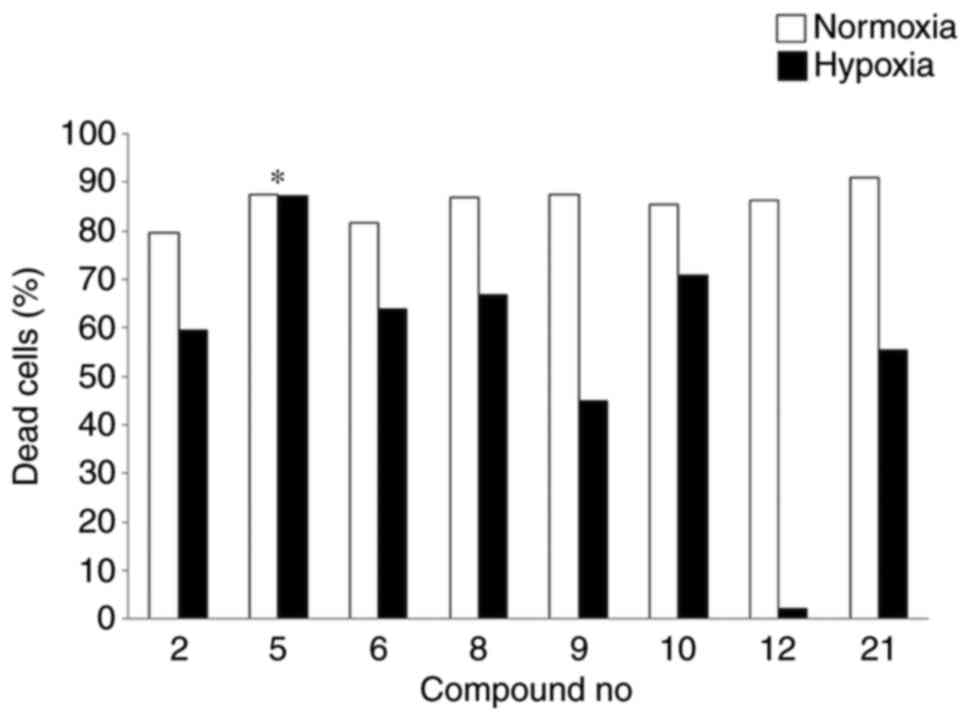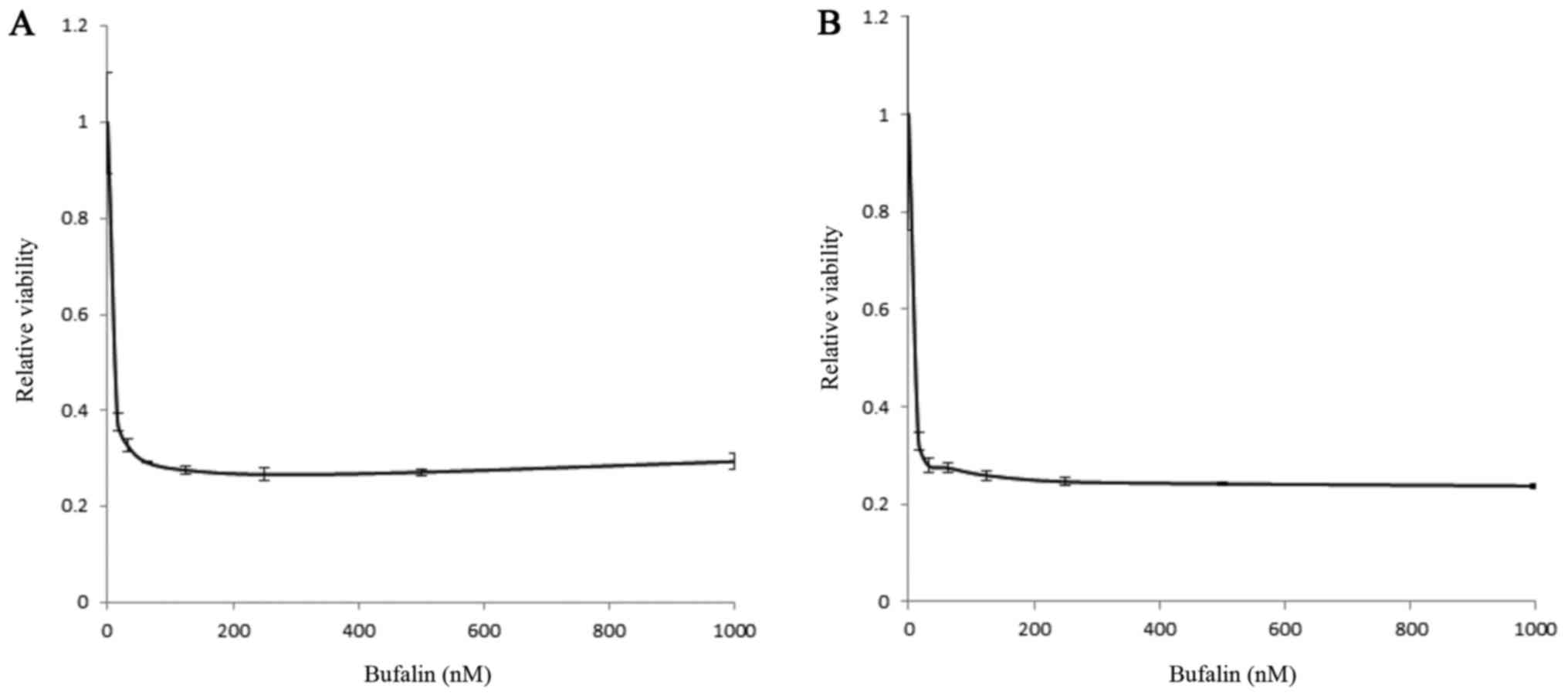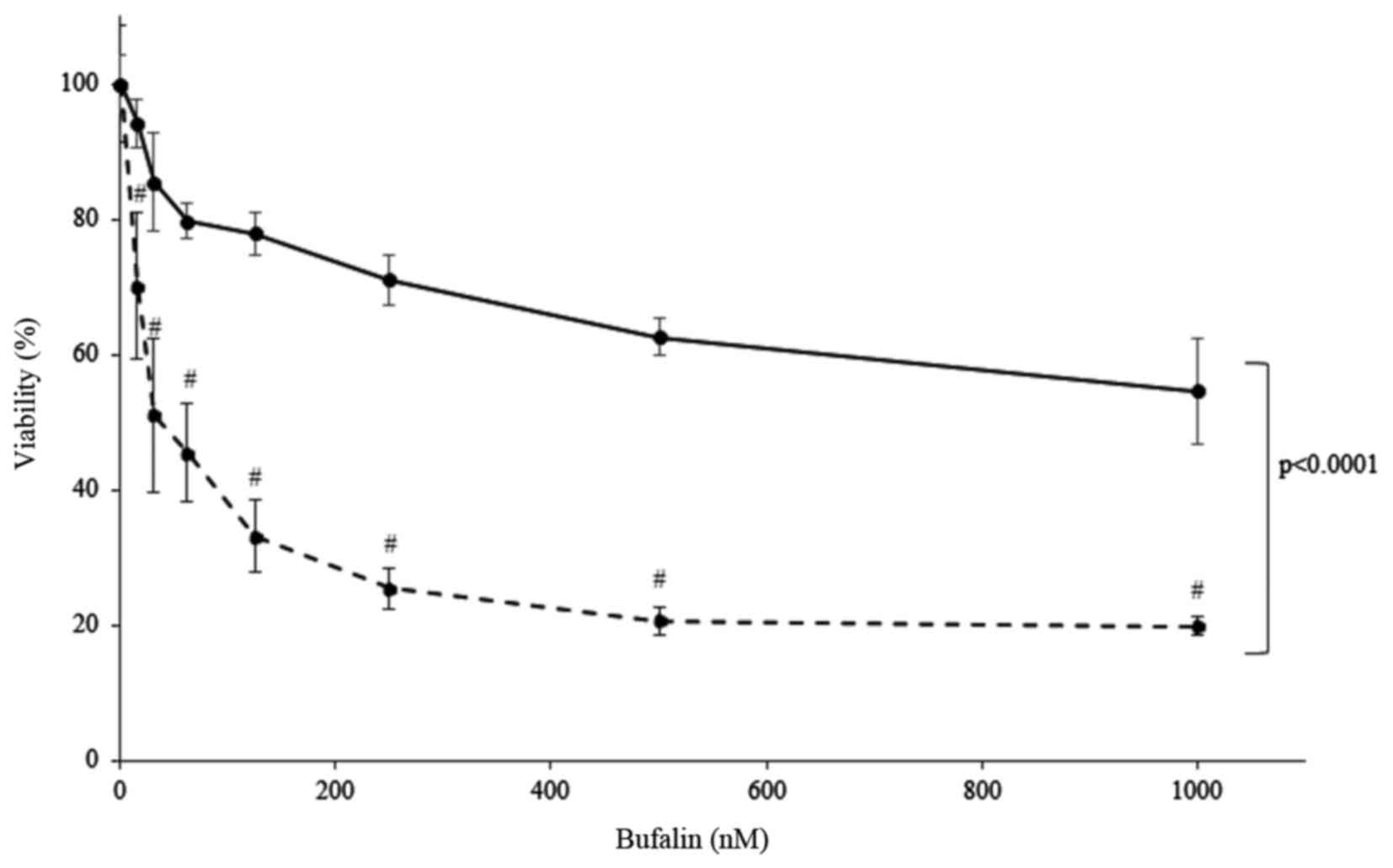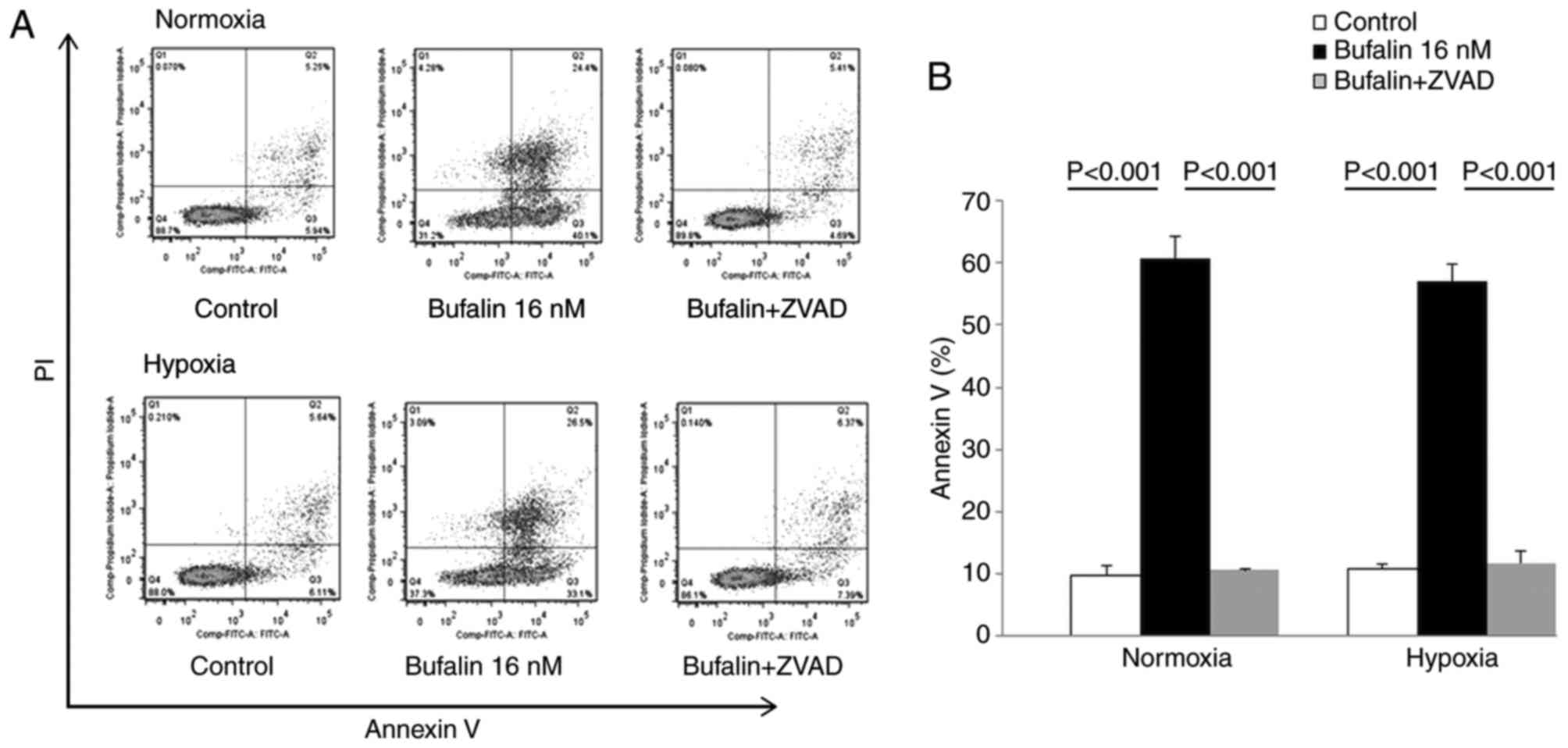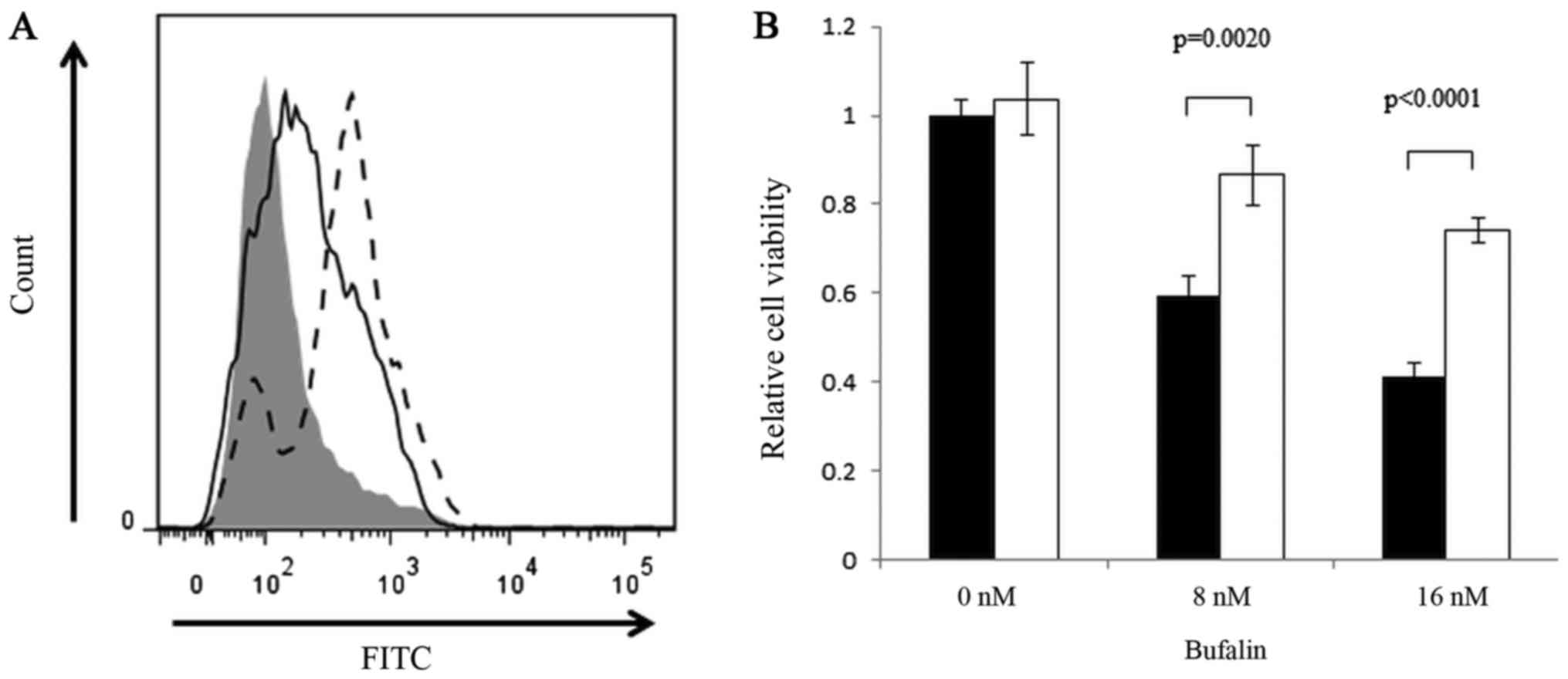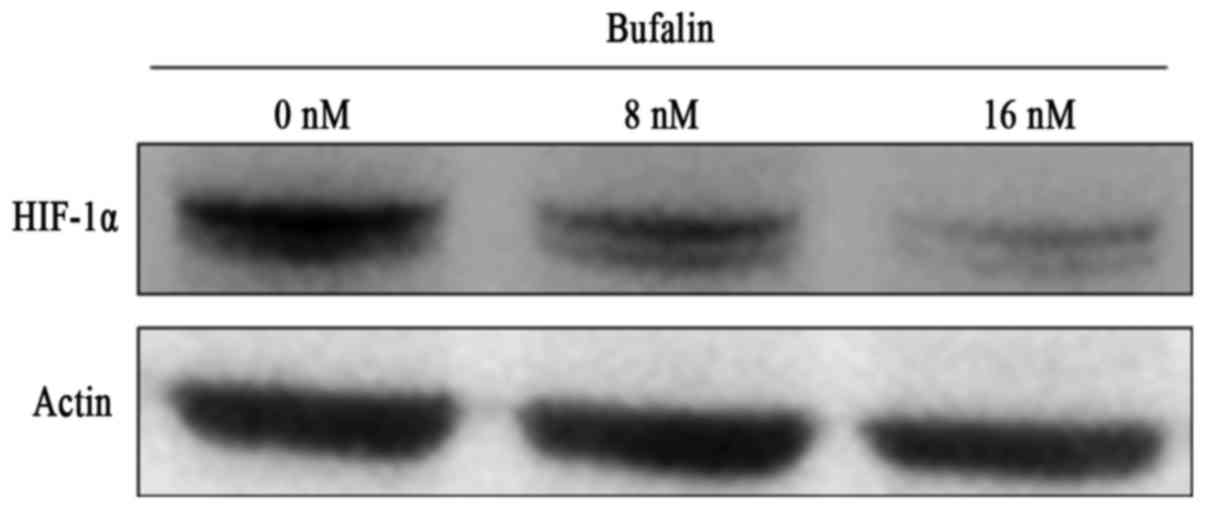Bufalin induces DNA damage response under hypoxic condition in myeloma cells
- Authors:
- Published online on: February 21, 2018 https://doi.org/10.3892/ol.2018.8091
- Pages: 6443-6449
-
Copyright: © Fujii et al. This is an open access article distributed under the terms of Creative Commons Attribution License.
Abstract
Introduction
Multiple myeloma (MM) is a hematological tumor of plasma cells that shows characteristic expansion of tumor cells within the bone marrow. Since the microenvironment within bone marrow is unique in terms of cytokine production and its interaction with various cells including MM cells, these environments can influence the survival and drug resistance of MM cells (1–3). In particular, oxygen concentration in the microenvironment is one of the greatest factors controlling survival of MM cells (4).
Oxygen plays an important role for MM cells by influencing the sensitivity to chemotherapeutic reagents. Previous studies showed that the sensitivity of MM cells to melphalan is reduced by hypoxia (5). Similar findings with other chemotherapeutic drugs have also been reported in various solid tumors (6–9). Therefore, these data suggest the existence of universal mechanisms by which oxygen concentration can regulate drug sensitivity. Notably, it is well known that oxygen concentration is extremely low in bone marrow, where MM cells survive and grow, and that drug-resistant MM cells can be generated within bone marrow, thus contributing to recurrence of the disease. Therefore, manipulation of hypoxia-induced drug resistance should be essential to improve survival of MM patients.
In this study, we searched for chemical compounds with the ability to kill myeloma cells under hypoxic conditions. We performed drug screening using a natural compound library and identified bufalin, a component of a Chinese medicine (Chan Su). We also analyzed the molecular mechanisms underlying the cytotoxicity of bufalin to MM cells under hypoxic conditions which has not been reported.
Materials and methods
Screening of compounds
A natural compound library consisting of 258 compounds was obtained from the Institute of Natural Medicine, Toyama University (Toyama, Japan). Each compound was supplemented to myeloma cell lines at a concentration of 10 µM and treated cells were cultured for 5 days under 1% oxygen concentration using a hypoxic culture chamber (Astec, Fukuoka, Japan).
Cell lines and cell culture
Two human myeloma cell lines, KMS12PE (10) and U266 (11) were utilized. Cells were cultured in RPMI-1640 medium supplemented with 10% fetal calf serum at 37°C with humidified air. Human peripheral blood mononuclear cells (PMBCs) were obtained from a healthy volunteer and purified by Ficoll density gradation.
Cytotoxic and apoptosis assays
Cytotoxicity of the compounds was analyzed by Cell Counting Kit-8 (Dohjin Chemicals, Kumamoto, Japan) or trypan blue dye exclusion assay according to the manufacturer's protocol. The MEBCYTO Apoptosis kit was used to detect apoptosis by flow cytometry using FACSVerse (BD Biosciences, Franklin Lakes, NJ, USA) according to the manufacturer's protocol. Melphalan and lenalidomide were purchased from Santa Cruz Biotechnology, Inc. (Santa Cruz, CA, USA) and Sigma-Aldrich; Merck KGaA, (Darmstadt, Germany), respectively. A pan-caspase inhibitor, ZVAD-fmk (Medical and Biological Laboratories, Nagoya, Japan), was utilized in some experiment at a concentration of 32 nM.
Detection of reactive oxygen species (ROS)
Production of ROS was analyzed using CellROX flow cytometry assay kits (Thermo Fisher Scientific, Yokohama, JAPAN) and FACS Verse according to the manufacturer's protocols.
Western blotting
Cell lysates were obtained by lysing cells with M-PER mammalian protein extraction reagent (Thermo Fisher Scientific, Inc., Yokohama, Japan) supplemented with phosphatase inhibitor cocktail and protease inhibitor cocktail (Nacalai Tesque, Kyoto, Japan). Antibodies for PARP, γ-H2A.X and HIF-1α were purchased from Cell Signaling Technology, Inc. (Tokyo, Japan).
Statistical analysis
Statistical analysis between two groups was performed by Student's t-test. For multiple group comparisons, one-way or two-way ANOVA was performed. The data were analyzed statistically by using GraphPad Prism software (GraphPad Software, Inc., La Jolla, CA, USA) and P<0.05 was considered to indicate a statistically significant difference.
Results
To confirm that myeloma cells show drug resistance under hypoxic conditions, we treated myeloma cells with melphalan and lenalidomide under normoxic or hypoxic conditions (Fig. 1). The LD50 values of melphalan in both KMS12PE and U266 cells under normoxic conditions were 3.0 and 1.8 µM and those of lenalidomide were 12.6 and 4.9 µM, respectively. Notably, the LD50 values of these reagents were elevated at hypoxic conditions. The LD50 values of melphalan in KMS12PE and U266 cells under hypoxic conditions were 6.7 and 9.9 µM, respectively, and the LD50 values of lenalidomide in KMS12PE and U266 cells were above 40 µM. Together these data indicate that myeloma cells showed drug resistance for these two reagents under low concentrations of oxygen.
We next screened 258 compounds in a natural compound library under hypoxic conditions in KMS12PE and U266 cells and found that 8 compounds induced significant cell death of more than 50% of the whole cell population. We analyzed cytotoxicity of each of these compounds in KMS12PE cells under both normoxic and hypoxic conditions and found that bufalin exerted high cytotoxicity at both conditions (compound no. 5 in Fig. 2) while other compounds showed reduction in cell death at hypoxic condition.
We thus further analyzed bufalin as a potential candidate that retains cytotoxicity regardless of oxygen concentration. A myeloma cell line, KMS12PE, was treated by bufalin at various concentrations either under normoxic or hypoxic conditions. As shown in Fig. 3, bufalin induced significant cytotoxicity below micro-molar levels independent of oxygen concentrations.
To elucidate whether bufalin shows toxicity to freshly isolated cells, MM cells obtained from patient bone marrow and PBMCs obtained from healthy volunteer were cultured and treated with bufalin. The results showed that bufalin induced significant cell death to primary MM cells, while it did not induce cell death in PBMCs as much as those observed in primary MM cells (P<0.0001, analyzed by two-way Anova) (Fig. 4). Together this suggests that bufalin may not show toxicity to non-malignant cells.
To further characterize the cytotoxicity by bufalin, we performed Annexin V/PI analysis of KMS12PE cells treated with 32 nM bufalin for 24 h either at normoxic or hypoxic conditions. Bufalin induced both early and late phase apoptosis and this increase in apoptosis was reduced by treatment with a caspase inhibitor (Fig. 5). These results indicate that the cytotoxicity induced by bufalin involves apoptosis mediated by caspase activation either in normoxic and hypoxic conditions.
As ROS is an inducer of apoptosis, we next analyzed the production of ROS in response to bufalin treatment. We observed a significant induction of ROS with bufalin treatment, and this induction was partially inhibited by N-acetyl cysteine (Fig. 6). This finding indicates that ROS production may be one of the contributors for the cytotoxic effects of bufalin.
Since several reports previously showed that bufalin induces DNA double strand breaks (DSBs) (12–14), we analyzed γ-H2AX induction, which is a hallmark of the DSB response. As shown in Fig. 7A, bufalin induced γ-H2AX in myeloma cells in a time-dependent manner under normoxic conditions. We also examined DSB induction under hypoxia conditions, and found induction of γ-H2AX by bufalin as found at normoxia (Fig. 7B). However, induction of γ-H2AX by melphalan at normoxia was found at fewer amounts and delayed as compared to bufalin. Moreover, melphalan-induced γ-H2AX even impaired at hypoxic conditions compared with normoxic conditions. Because melphalan did not show anti-tumor effect not earlier than 24 h, western blot analysis at earlier occasions is not shown. Cleavage of PARP was also observed in response to bufalin treatment regardless of oxygen concentration, while melphalan-inducing PARP cleavage was inhibited at hypoxic conditions (Fig. 7A and B).
Since HIF-1α is induced and considered to contribute drug resistance in hypoxia, we evaluated whether bufalin modulates HIF-1α under hypoxic conditions. Interestingly, treatment of myeloma cells with bufalin at 16 nM for 24 h significantly inhibited the expression of HIF-1α in hypoxic conditions (Fig. 8), suggesting that the cytotoxic effect of bufalin under hypoxia may involve the reduction of HIF-1α.
Discussion
Oxygen concentration plays a crucial role in the survival of cancer cells. Low oxygen concentration induces expression of numerous genes regulated by HIF-1α, a master transcriptional factor under hypoxic conditions. One of the features mediated by hypoxia is acquisition of drug resistance. Previous reports demonstrated acquisition of drug resistance by hypoxia in various types of cancer cells (4,7–9,15). Mechanisms regulating drug resistance under hypoxia have been described, involving microRNAs (16), the multi-drug resistant (MDR) gene (15,17) or the autophagy pathway (18). Modulating these pathways is thought to re-sensitize tumor cells to anti-cancer reagents.
Previous studies have examined the correlation between hypoxia and cancer stem cells other than drug resistance (19). Hypoxic conditions can transform tumor cells to cancer stem cells and are required for the maintenance of cancer stem cells (20–22). Targeting cancer stem cells should be important to eradicate tumor cells. We previously reported that hypoxic conditions transform myeloma cells to an immature phenotype, suggesting that myeloma stem cells may adapt to hypoxic conditions (23). Because melphalan and lenalidomide showed reduced efficacy at hypoxic conditions as shown in this report, our results suggest that these treatments may not retain the ability to target myeloma stem cells, although we did not perform confirmatory experiments using myeloma stem cells this time. Recently, Sun et al, reported that bufalin inhibits stemness and overcome drug resistance of colon cancer cells (24). This finding enforces our results and warrants usage of bufalin to exterminate myeloma stem cells.
We found, for the first time, that bufalin induced the DSB response in MM cells independent of oxygen concentrations. Although DSB response mediated by bufalin at normoxic condition has scarcely been reported in solid tumors, especially interacting to topoisomerase II (12–14), the function of bufalin under hypoxic conditions has not been fully elucidated. Only two previous reports described a correlation between bufalin and hypoxia in colon, cervical and hepatocellular carcinoma cells, and these studies suggested that reduction of HIF-1 could be involved in the cytotoxicity induced by bufalin (25,26). Interestingly, we found a decrease of HIF-1α in response to treatment with bufalin under hypoxic conditions in MM cells. As a growing body of evidence has shown a central role of hypoxia in the acquisition of drug resistance, targeting HIF-1α is now considered to be an important approach to overcome drug resistance (27,28). Indeed, targeting HIF-1α sensitizes myeloma cells to chemotherapeutic agents and reduces the number of myeloma stem cells (5,29). Our finding of HIF-1α inhibition by bufalin should contribute to the development of a HIF-1α targeted strategy for treatment of MM. The demonstrated cytotoxicity by bufalin regardless of oxygen concentration enforces the significance of bufalin in the treatment of cancers survive within hypoxic niche other than myeloma. However, we did not evaluated ubiquitination or degradation of HIF-1 by the treatment with bufalin at this time. Regulatory effect of bufalin in expression of HIF-1 remains to be elucidated.
Adverse events, especially cardiotoxicity (30), caused by bufalin is an important issue when using this reagent at clinical setting. However, the concentration inducing cardiotoxicity was estimated as 1 mM which was significantly higher than those exerting anti-tumor effect presented in this manuscript, suggesting clinical usage of bufalin might spare cardiotoxicity. Indeed, there have been several reports showing in vivo findings (31,32). Given the low working concentration of bufalin, as low as nano-molar levels, the achievement of an effective concentration of bufalin should be possible. Successful in vivo treatment of an osteosarcoma-bearing mouse by bufalin suggests its future usage in the clinical setting (33). In addition, our findings demonstrating the low toxicity of bufalin in normal PBMCs implies a low toxicity profile for normal tissues.
Acknowledgements
The authors would like to thank Dr Gabrielle White Wolf for editing a draft of this manuscript.
Funding
This study was supported by in part by a grant from the Japanese Amyloidosis Research Committee from the Ministry of Health, Labor and Welfare (grant no. ippan-022).
Availability of data and materials
The datasets used and/or analyzed during the current study are available from the corresponding author on reasonable request.
Authors' contributions
EF, YI and MK executed the experiments. NN, SE, SF, NW, YO and TS supervised the experimental procedures and analysed the results. YK performed the statistical analysis. HH conducted experiments, organized the discussions and finalized the manuscript.
Ethics approval and consent to participate
Not applicable.
Consent for publication
Not applicable.
Competing interests
The authors declare that they have no competing interests.
References
|
Di Marzo L, Desantis V, Solimando AG, Ruggieri S, Annese T, Nico B, Fumarulo R, Vacca A and Frassanito MA: Microenvironment drug resistance in multiple myeloma: Emerging new players. Oncotarget. 7:60698–60711. 2016. View Article : Google Scholar : PubMed/NCBI | |
|
Kawano Y, Moschetta M, Manier S, Glavey S, Görgün GT, Roccaro AM, Anderson KC and Ghobrial IM: Targeting the bone marrow microenvironment in multiple myeloma. Immunol Rev. 263:160–172. 2015. View Article : Google Scholar : PubMed/NCBI | |
|
Wang J, Faict S, Maes K, De Bruyne E, Van Valckenborgh E, Schots R, Vanderkerken K and Menu E: Extracellular vesicle cross-talk in the bone marrow microenvironment: Implications in multiple myeloma. Oncotarget. 7:38927–38945. 2016.PubMed/NCBI | |
|
Garvalov BK and Acker T: Implications of oxygen homeostasis for tumor biology and treatment. Adv Exp Med Biol. 903:169–185. 2016. View Article : Google Scholar : PubMed/NCBI | |
|
Hu Y, Kirito K, Yoshida K, Mitsumori T, Nakajima K, Nozaki Y, Hamanaka S, Nagashima T, Kunitama M, Sakoe K and Komatsu N: Inhibition of hypoxia-inducible factor-1 function enhances the sensitivity of multiple myeloma cells to melphalan. Mol Cancer Ther. 8:2329–2338. 2009. View Article : Google Scholar : PubMed/NCBI | |
|
Daster S, Amatruda N, Calabrese D, Ivanek R, Turrini E, Droeser RA, Zajac P, Fimognari C, Spagnoli GC, Iezzi G, et al: Induction of hypoxia and necrosis in multicellular tumor spheroids is associated with resistance to chemotherapy treatment. Oncotarget. 8:1725–1736. 2017. View Article : Google Scholar : PubMed/NCBI | |
|
Zhao W, Xia SQ, Zhuang JP, Zhang ZP, You CC, Yan JL and Xu GP: Hypoxia-induced resistance to cisplatin-mediated apoptosis in osteosarcoma cells is reversed by gambogic acid independently of HIF-1α. Mol Cell Biochem. 420:1–8. 2016. View Article : Google Scholar : PubMed/NCBI | |
|
Qin Y, Roszik J, Chattopadhyay C, Hashimoto Y, Liu C, Cooper ZA, Wargo JA, Hwu P, Ekmekcioglu S and Grimm EA: Hypoxia-driven mechanism of vemurafenib resistance in melanoma. Mol Cancer Ther. 15:2442–2454. 2016. View Article : Google Scholar : PubMed/NCBI | |
|
Mao XG, Wang C, Liu DY, Zhang X, Wang L, Yan M, Zhang W, Zhu J, Li ZC, Mi C, et al: Hypoxia upregulates HIG2 expression and contributes to bevacizumab resistance in glioblastoma. Oncotarget. 7:47808–47820. 2016. View Article : Google Scholar : PubMed/NCBI | |
|
Ohtsuki T, Yawata Y, Wada H, Sugihara T, Mori M and Namba M: Two human myeloma cell lines, amylase-producing KMS-12-PE and amylase-non-producing KMS-12-BM, were established from a patient, having the same chromosome marker, t(11;14)(q13;q32). Br J Haematol. 73:199–204. 1989. View Article : Google Scholar : PubMed/NCBI | |
|
Ikeyama S, Nakagawa S, Arakawa M, Sugino H and Kakinuma A: Purification and characterization of IgE produced by human myeloma cell line, U266. Mol Immunol. 23:159–167. 1986. View Article : Google Scholar : PubMed/NCBI | |
|
Pastor N and Cortés F: Bufalin influences the repair of X-ray-induced DNA breaks in Chinese hamster cells. DNA Repair (Amst). 2:1353–1360. 2003. View Article : Google Scholar : PubMed/NCBI | |
|
Wu SH, Hsiao YT, Chen JC, Lin JH, Hsu SC, Hsia TC, Yang ST, Hsu WH and Chung JG: Bufalin alters gene expressions associated DNA damage, cell cycle and apoptosis in human lung cancer NCI-H460 cells in vitro. Molecules. 19:6047–6057. 2014. View Article : Google Scholar : PubMed/NCBI | |
|
Wu SH, Wu TY, Hsiao YT, Lin JH, Hsu SC, Hsia TC, Yang ST, Hsu WH and Chung JG: Bufalin induces cell death in human lung cancer cells through disruption of DNA damage response pathways. Am J Chin Med. 42:729–742. 2014. View Article : Google Scholar : PubMed/NCBI | |
|
Li D, Zhou L, Huang J and Xiao X: Effect of multidrug resistance 1/P-glycoprotein on the hypoxia-induced multidrug resistance of human laryngeal cancer cells. Oncol Lett. 12:1569–1574. 2016. View Article : Google Scholar : PubMed/NCBI | |
|
Zhou C, Tan W, Lv H, Gao F and Sun J: Hypoxia-inducible microRNA-488 regulates apoptosis by targeting Bim in osteosarcoma. Cell Oncol (Dordr). 39:463–471. 2016. View Article : Google Scholar : PubMed/NCBI | |
|
Chen YL, Yang TY, Chen KC, Wu CL, Hsu SL and Hsueh CM: Hypoxia can impair doxorubicin resistance of non-small cell lung cancer cells by inhibiting MRP1 and P-gp expression and boosting the chemosensitizing effects of MRP1 and P-gp blockers. Cell Oncol (Dordr). 39:411–433. 2016. View Article : Google Scholar : PubMed/NCBI | |
|
Feng H, Wang J, Chen W, Shan B, Guo Y, Xu J, Wang L, Guo P and Zhang Y: Hypoxia-induced autophagy as an additional mechanism in human osteosarcoma radioresistance. J Bone Oncol. 5:67–73. 2016. View Article : Google Scholar : PubMed/NCBI | |
|
Mohyeldin A, Garzón-Muvdi T and Quiñones-Hinojosa A: Oxygen in stem cell biology: A critical component of the stem cell niche. Cell Stem Cell. 7:150–161. 2010. View Article : Google Scholar : PubMed/NCBI | |
|
Hoshino H, Nagano H, Haraguchi N, Nishikawa S, Tomokuni A, Kano Y, Fukusumi T, Saito T, Ozaki M, Sakai D, et al: Hypoxia and TP53 deficiency for induced pluripotent stem cell-like properties in gastrointestinal cancer. Int J Oncol. 40:1423–1430. 2012.PubMed/NCBI | |
|
Li Z and Rich JN: Hypoxia and hypoxia inducible factors in cancer stem cell maintenance. Curr Top Microbiol Immunol. 345:21–30. 2010.PubMed/NCBI | |
|
Ma Y, Liang D, Liu J, Axcrona K, Kvalheim G, Stokke T, Nesland JM and Suo Z: Prostate cancer cell lines under hypoxia exhibit greater stem-like properties. PLoS One. 6:e291702011. View Article : Google Scholar : PubMed/NCBI | |
|
Kawano Y, Kikukawa Y, Fujiwara S, Wada N, Okuno Y, Mitsuya H and Hata H: Hypoxia reduces CD138 expression and induces an immature and stem cell-like transcriptional program in myeloma cells. Int J Oncol. 43:1809–1816. 2013. View Article : Google Scholar : PubMed/NCBI | |
|
Sun J, Xu K, Qiu Y, Gao H, Xu J, Tang Q and Yin P: Bufalin reverses acquired drug resistance by inhibiting stemness in colorectal cancer cells. Oncol Rep. 38:1420–1430. 2017. View Article : Google Scholar : PubMed/NCBI | |
|
Wang H, Zhang C, Xu L, Zang K, Ning Z, Jiang F, Chi H, Zhu X and Meng Z: Bufalin suppresses hepatocellular carcinoma invasion and metastasis by targeting HIF-1α via the PI3K/AKT/mTOR pathway. Oncotarget. 7:20193–20208. 2016.PubMed/NCBI | |
|
Xie CM, Liu XY, Yu S and Cheng CH: Cardiac glycosides block cancer growth through HIF-1α- and NF-κB-mediated Plk1. Carcinogenesis. 34:1870–1880. 2013. View Article : Google Scholar : PubMed/NCBI | |
|
Jahanban-Esfahlan R, de la Guardia M, Ahmadi D and Yousefi B: Modulating tumor hypoxia by nanomedicine for effective cancer therapy. J Cell Physiol. 233:2019–2031. 2017. View Article : Google Scholar : PubMed/NCBI | |
|
Yu T, Tang B and Sun X: Development of inhibitors targeting hypoxia-inducible factor 1 and 2 for cancer therapy. Yonsei Med J. 58:489–496. 2017. View Article : Google Scholar : PubMed/NCBI | |
|
Borsi E, Terragna C, Brioli A, Tacchetti P, Martello M and Cavo M: Therapeutic targeting of hypoxia and hypoxia-inducible factor 1 alpha in multiple myeloma. Transl Res. 165:641–650. 2015. View Article : Google Scholar : PubMed/NCBI | |
|
Bick RJ, Poindexter BJ, Sweney RR and Dasgupta A: Effects of Chan Su, a traditional Chinese medicine, on the calcium transients of isolated cardiomyocytes: Cardiotoxicity due to more than Na, K-ATPase blocking. Life Sci. 72:699–709. 2002. View Article : Google Scholar : PubMed/NCBI | |
|
Liu M, Feng LX, Sun P, Liu W, Wu WY, Jiang BH, Yang M, Hu LH, Guo DA and Liu X: A novel bufalin derivative exhibited stronger apoptosis-inducing effect than bufalin in A549 lung cancer cells and lower acute toxicity in mice. PLoS One. 11:e01597892016. View Article : Google Scholar : PubMed/NCBI | |
|
Wu SH, Bau DT, Hsiao YT, Lu KW, Hsia TC, Lien JC, Ko YC, Hsu WH, Yang ST, Huang YP and Chung JG: Bufalin induces apoptosis in vitro and has antitumor activity against human lung cancer xenografts in vivo. Environ Toxicol. 32:1305–1317. 2017. View Article : Google Scholar : PubMed/NCBI | |
|
Xie XB, Yin JQ, Wen LL, Gao ZH, Zou CY, Wang J, Huang G, Tang QL, Colombo C, He WL, et al: Critical role of heat shock protein 27 in bufalin-induced apoptosis in human osteosarcomas: A proteomic-based research. PLoS One. 7:e473752012. View Article : Google Scholar : PubMed/NCBI |




